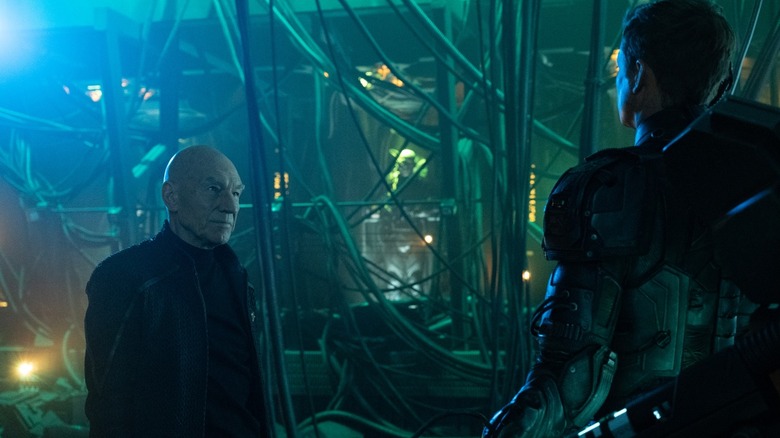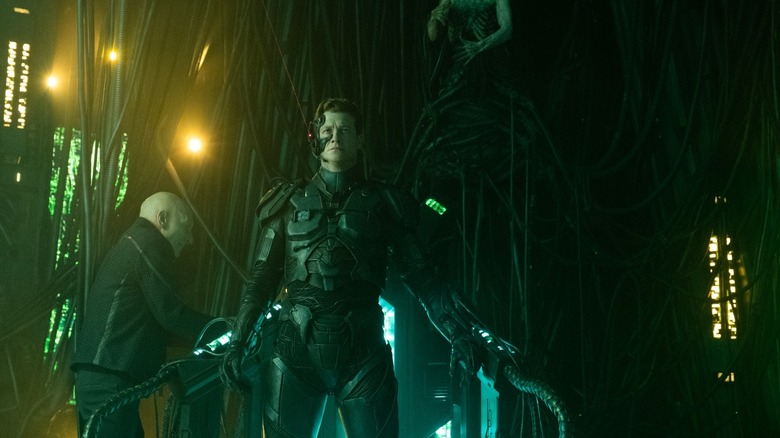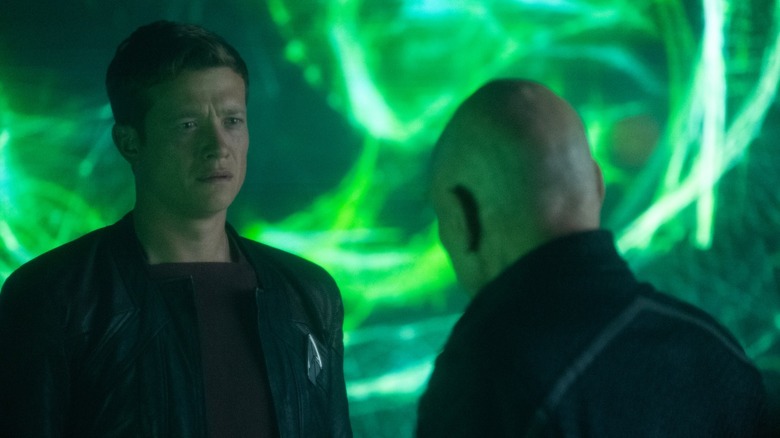How Star Trek: Picard Pulled Off Jean-Luc's Journey Into The Borg Hive Mind
Throughout the third season of "Star Trek: Picard," a mystery was afoot. A vicious cadre of vengeful Changelings had broken into a Starfleet black site and absconded with the dead body of Jean-Luc Picard (Patrick Stewart). One might recall that the first season of "Picard" ended with the title character dying, and his consciousness being shunted into an android golem. The dead biological body had a mysterious illness in its brain that the Changelings intended to use for nefarious purposes. The mysterious illness was also connected to Jack Crusher (Ed Speleers), Picard's adult son who seemed to be manifesting psychic X-Men powers.
The reveal in the penultimate episode of the show was that Picard's mysterious brain illness was not a disease at all, but a gene left behind by the Borg when he was briefly assimilated into their collective decades ago. The gene manifested in Jack as psychic superpowers, and allowed the Borg to "call" to him and suck him into their fold. The gene was also implanted into hundreds of Starfleet transporters, effectively assimilating anyone who used them. The final episode featured an assimilated Jack doing the Borg's dirty work, and an assimilated fleet of Starfleet vessels attacking Earth.
The only way to save the day was for the 110-year-old Picard to meet the Borg-ified Jack in person, plug his brain into the Borg hive mind, and communicate with his son in a mysterious interdimensional psychic space. While in said pocket dimension, Picard weeps that he loves his son, and Jack weeps that he loves his dad, everything is cleared up with the power of love, and Jack — also Earth — is rescued.
In a recent interview with Awards Radar, "Picard" editor Drew Nichols explained that he needed to invent what the Borg subliminal space looked like.
The Borg dreamspace
Despite multiple assimilations throughout the "Star Trek" timeline, and many elaborate descriptions of how horrible it felt. No Trek show had ever really visualized a dream-like first-person perspective of what it was like inside the hive mind. "Star Trek: Discovery" recently featured a psychic dreamspace between a Trill and their lover, and "Picard" featured a similar dreamspace shared by Data (Brent Spiner) and his evil twin Lore, so it was high time for Picard to try.
Nichols was tasked by showrunner Terry Matalas with what the assimilation rescue might look like, and he immediately began mentally accruing Borg moments from older Trek shows hoping to construct a montage.
"One of the cooler things I think, was probably in the finale, where Jean-Luc goes back into the Borg cube. He plugs himself back into the collective to go rescue his son. And that was in the script. Terry was like, 'We got to see this journey.' What's it like going into the Collective? So it was just a question that he put out there. And he's like, 'Why don't you just try to figure something out?' So me and my assistant editor, Justin Block, we pored through some of the shows and the movies to see if there's anything with Locutus that we could possibly use, and some stock footage bits."
Locutus was Picard's name when he was assimilated. The Locutus story appeared in the two-part "Star Trek: The Next Generation" episode "The Best of Both Worlds." Picard also experienced flashbacks to being locutus in the 1996 feature film "Star Trek: First Contact." That was plenty for Nichols and Block to start with.
Inside the Collective
Nichols visualized the psychic interior of the Borg Collective to look like a manufactured simulation, pumped directly into a drone's mind. While in there, the drone doesn't appear to be Borg-ified, and can still communicate with other Borgs in their original, pre-assimilated state. In the final in-Borg scene, Picard and Jack converse in an open, black space, surrounded by massive, eerie, green lights. The lights appeared to represent Borg neurons and thought patterns.
Nichols liked the look, and he used the word "cool" multiple times. He also edited together a lot of old Locutus footage, as well as a great deal of vintage Borg sound effects from older "Star Trek" episodes. Also of note: the Borg played a large part in "Star Trek: Voyager," so there was more than just the specific Locutus appearances that Nichols could draw from. He said:
"So that was fun. And kind of, you know, crazy, because again, I had kind of no directive beyond just 'make it cool'. We're going into the Borg Collective. And then we're in the Borg Collective, which again, we've never really seen before, what's that like to be in a simulation? It was through some bits from 'First Contact,' and some stock footage and some clever sound design stuff that Dustin and our sound design team did. And I think it turned out kind of really cool."
After the rescue, Jack went off to Starfleet Academy, the Borg were all blown up, the assimilated were cured, and Picard got to have a drink with his buddies. Farewell, Jean-Luc. We shall ne'er see your like again.


